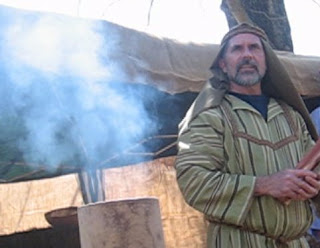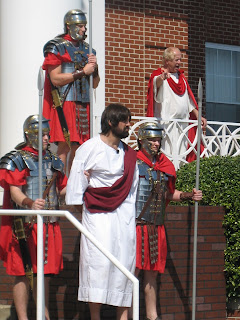It troubles me to see so many, including close friends of mine, deeply involved in the debate over women's ordination. I will demonstrate in this short paper that this debate is not rooted in scripture. Instead, it's a debate over a traditional practice that has no biblical basis. Not all traditions are bad, but this one has slowly rotted over the years and developed quite a stink. So let's cover our noses and begin to examine the topic.
The first biblical example of “ordination” was the ceremony dedicating the old testament priesthood. God instituted the the priesthood and it's ceremony of dedication as part of a greater prophetic ministry that looked forward to the day when Christ would become the lamb of the world. On the moment of his death angels sent from God tore the veil in the temple from top to bottom symbolizing the end of the sacrificial system—with it's priesthood and “ordination” ceremony.
The priesthood was replaced by the reality of Christ. The apostle John speaking of the event wrote that we were made “kings and priests unto God1”. No longer would an earthly priest stand between us and God, but the followers of God would worship “in spirit and in truth2”. The apostle Paul speaking of this same truth urged his fellow Jews to “come boldly unto the throne of grace3”.
As Christians today we speak of a “priesthood of all believers”. The former priests and their “ordination” ceremonies have passed into history4. Since the New Testament church had no priests, were there any ceremonies that we could equate with today's ordination? The answer is yes5.
During Christ's ministry he selected the twelve apostles6 and later the seventy7 to act as messengers for Him with authority to act in His name. The early church adopted that same practice by officially recognizing individuals for various temporary or permanent roles. The first appointment was that of Matthias to replace Judas as one of the twelve apostles8. The next appointment is more unexpected and very relevant to the modern ordination discussion.
A dispute arose over the distribution of food to widows. Those of Greek ethnicity were being overlooked. To solve this problem they appointed seven men to be be in charge of the food distribution. What follows is the first detailed description of an “ordination” in which the apostles prayed then “laid hands on them”9.
These “deacons” did not fill the modern deacon role (maintaining the church building, collecting offerings), but were assigned to distribute welfare to widows. It sounds disturbingly close to what we today would call a “bureaucrat”. Oddly enough, the disciples of Christ considered the ministry of these “bureaucrats” so important they ordained them. Luke, the writer of the book of Acts considered it significant enough to devote six verses to tell us about it.
As we look through the rest of the New Testament we find that while the church was picky about the character of the person being ordained, it was not picky about what role deserved an “ordination”. Missionaries, diplomats10, bishops (pastor/elder) and deacons (welfare distribution) were similarly “ordained”11.
This fits perfectly with the scriptural principles that all work is performed for Christ12 and that all roles are equally important. Paul writing to the Corinthians states: "And the eye cannot say unto the hand, I have no need of thee: nor again the head to the feet, I have no need of you. Nay, much more those members of the body, which seem to be more feeble, are necessary."13
It is important to note that official status in the New Testament church was not required to perform duty on behalf of the church. Acts is filled with stories and activities of the non-ordained. All members were called upon to fulfill Christ's commission to evangelize14 and perform good deeds15. However, certain roles did benefit from official sanction.
Today's ordination process is very different. While the character of the ordained is still very important, today's ordination primarily emphasizes the pastoral role. This is likely a piece of Roman Catholic tradition that survived the reformation. Within Adventist tradition we have a primary “ordination” for pastors with lesser “ordination” for local elders and deacons16. Other official roles—for example, teachers, treasury, trust and legal—may be ignored or given a lesser service.17 That is quite different from the New Testament practice of "ordaining" everyone who performed official duties for the church.
As Christians who believe in the Bible as the basis for belief and practice this is very important. When we find a situation where our traditions clash with scriptural practice—in particular if the area is producing disunity within the church—we should resolve the problem by changing our practice to match scripture. Today's list of roles is much longer than that of the early church: lawyers, treasurers, teachers, pilots, missionaries, pastors, video producers and so on. But the concept is the same. Anyone who is officially sanctioned by the church for any role should be ordained.
So how does this resolve the issue of women's ordination?
"For” supporters—read this:
God gives gifts to women and they should be allowed to exercise those gifts as official representatives of God's church. That is biblical and we as a church should do this.
“Against” supporters—read this:
God created two genders for a reason and has given different responsibilities and typically different gifts to each gender. This too is biblical and as a church we should do this.
By ordaining everyone who occupies an official status in the church we can accomplish both. If a man has a marked gift to lead, then ordain him to pastoral work. If a woman has a marked gift to nurture children, then ordain her to lead our Sabbath schools or teach in our schools. Both genders can serve God and if called serve in an official church capacity in line with the gifts God has given them.
Now, those of you who (like me) tend to hypothesize and perhaps second guess a bit too much— you are asking right now, “What about the rare man who possesses exceptional gifts that are stereotypically found in women?” The good news is we have a biblical example18 that solves this problem. The prophetess Deborah occupied a role typically filled by men: judge of Israel. But that wasn't all. In an age when warfare was physical, brutal and masculine she went to war in order to strengthen the courage of a general named Barak. However, she chastised him for his unwillingness to move forward without her. God had given Barak gifts as well—gifts more typical for a man—but gifts non-the-less that God expected him to use and not depend on Deborah's gifts.
I see in this story an affirmation to both sides of the gender question. First, God is perfectly OK with the individual who's unusual gift set leads them to serve in ways that are not typical of their gender. Secondly, that does not excuse the majority of us with a more typical distribution of gifts. We are also called.
Let's not make the battle between “for” and “against” become our identity as Adventists. Let's abandon the narrow use of ordination and adopt the example of the New Testament church. Let us use a service of ordination to recognize the importance of every single role in the modern church--from missionary, to pilot, to deacon, to pastor; recognizing all as critical pieces in accomplishing God's purpose in his church.
P.s. If you agree with the message of this article please take the time to share it with someone else. We need to become louder than the other voices in this debate if we are to be heard .
If you don't agree, please post a comment explaining why--I'd like to modify/improve this article.
Notes:
- Revelation 1:6 (All quoted verses are in the King James Version)
- I am not suggesting for a moment that these are without meaning. While the practice of the sacrificial system has ended, the message is endless. Many of you may have seen or heard of Oklahoma Academy's “Messiah's Mansion”. It's a full scale reproduction of the tabernacle that travels around the country to explain the meaning of the tabernacle services and it's message about Christ to literally tens of thousands of people. For more information http://www.mbsanctuary.com/






























